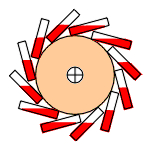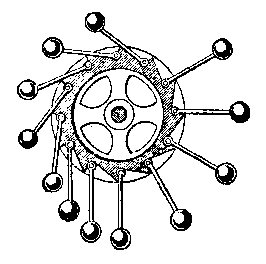A long history of failures.
Early civilizations had little motivation to seek perpetual motion, but they had no reason to doubt that such a thing might be possible in nature. They observed the heavens, and kept records of positions of stars and planets, which demonstrated clearly that these motions reliably repeated, and that this majestic dance of the planets never noticably "slowed down" and was likely eternal. The Greeks even supposed that things in the heavenly realm were not made of ordinary matter, but a perfected substance, the "quintessence". In the heavenly realm everything was perfect, so motions of celestial objects could continue forever. But in the earthly realm, that of the four elements earth, water, air and fire, things naturally seek, but never achieve, perfection. This would suggest, philosophically, that perpetual motion was not possible on Earth.To the ancients, the notion of perpetual motion was quite distinct from the possibility of an inexhaustable source of energy in the form of useful work. These civilizations had little need to seek such machines for doing work. Natural energy resources such as wind and water power were sufficient for their needs, and animals and slaves provided the work required for commerce.
 Still, some were intrigued by the possibility of achieving perpetual motion by mechanical means.
The first documented proposals for perpetual motion machines originated in India, in about the 8th century. One, described by the Indian author Bhaskara (c. 1159), was a wheel with containers of mercury
around its rim. As the wheel turned, the mercury moved within
the containers in such a way that the wheel would always be heavier on one
side of the axle. [Graphic by Hans-Peter Gramatke, used with permission.]
Still, some were intrigued by the possibility of achieving perpetual motion by mechanical means.
The first documented proposals for perpetual motion machines originated in India, in about the 8th century. One, described by the Indian author Bhaskara (c. 1159), was a wheel with containers of mercury
around its rim. As the wheel turned, the mercury moved within
the containers in such a way that the wheel would always be heavier on one
side of the axle. [Graphic by Hans-Peter Gramatke, used with permission.]
One can imagine that many persons built such devices, filling the containers with mercury, sand, water, or rolling balls. No doubt it seemed plausible to them that with a little nudge the wheel would turn, then turn faster and faster, driven by continual imbalance of weight.
But real wheels of this sort would only turn briefly, then stop. Given a faster initial speed they would turn longer, but they always come to rest. Perhaps, they thought, a little tinkering with the angle of the vials would help. Perhaps a larger number of vials would be better, or a larger wheel. No modifications helped. The perversity of the wheel must have been discouraging and disheartening, but for some, hope never dies. Perhaps it's all the fault of that pesky friction, they may have thought.
 These ideas re-appear in Europe in the year 1235. The French architect
Villard de Honnecort described an overbalanced wheel with hinged hammers
equally spaced around its rim. This idea had also originated in India.
[The picture displays ambiguous perspective.
The wheel is actually supposed to be perpendicular to the frame and to the
horizontal axle.] Villard's description (translated) is:
These ideas re-appear in Europe in the year 1235. The French architect
Villard de Honnecort described an overbalanced wheel with hinged hammers
equally spaced around its rim. This idea had also originated in India.
[The picture displays ambiguous perspective.
The wheel is actually supposed to be perpendicular to the frame and to the
horizontal axle.] Villard's description (translated) is:
Many a time have skillful workmen tried to contrive a wheel that should turn of itself; here is a way to make such a one, by means of an uneven number of mallets, or by quicksilver.
The reference to quicksilver (mercury) indicates that Villard was familiar with the Bhaskara device. Villard claimed his machine should be useful for sawing wood and raising weights. His diagram shows seven hammers, and he insisted on an odd (uneven) number of hammers, explaining,
...there will always be four on the downward side of the wheel and only three on the upward side; thus the mallet or bag will always fall over to the left as it reaches the top, ad infinitum.One may speculate that part of the rationale for the number of hammers on this device is the simple observation that an odd number of weights can't be divided into two equal numbers, so one side of the wheel must always have one more weight than the other. But the extra weight is equally often on one side of the wheel as on the other, so this argument fails. But, whether the number of hammers is odd or even, such a wheel comes to rest very soon.
 This "overbalanced wheel" idea reappeared in an astounding variety of forms over the centuries.
We show a better diagram from a later time. A system of pegs or stops was
required to hold the hammers at a large distance from the axle after they
flipped over the top and allow them to hang freely as they came around the
other side.
This "overbalanced wheel" idea reappeared in an astounding variety of forms over the centuries.
We show a better diagram from a later time. A system of pegs or stops was
required to hold the hammers at a large distance from the axle after they
flipped over the top and allow them to hang freely as they came around the
other side.
The laws of levers had been well known since the time of Archimedes. Perhaps the rationale was that the balls had larger lever arms on one side of the axle. However, this argument actually shows the futility of this device. Even though there are fewer balls on one side of the axle at any given position, these have larger lever arms. When one sums the products of mass and lever arm for all hammers, the result is zero. The system is balanced at seven positions if it has seven hammers.
Perhaps a different process tempted people to think the wheel would maintain motion. As a hammer swings and falls near the top of the wheel, the wheel might gain some speed when the hammer hits its peg. But the hammer slows the wheel during its fall, so the net gain in speed is zero.
We have mostly second-hand accounts of the understanding of the principles of this machine. However, I do not think that the folks who were fascinated with this idea were unaware of the static balance condition of the wheel. The wheel would not initiate motion from rest. You must give it a push. The dynamics of motion were not well understood. Perhaps the wheel could maintain motion once it was manually set in motion, with the hammers giving it extra boost as they rapidly flipped across the top, perhaps this was due to some "advantage" obtained from the motion of each weight flipping to a position with a larger lever arm. Things poorly understood seem mysterious, tantalizing restless minds, who imagine that wonderful secrets lurk in those murky realms, awaiting discovery by diligent seekers.
 This flipping action is much like that of a sling that gives a person the ability to throw a rock a greater distance, or the sling siege engine catapult known as the Trebuchet. Honnecort
wrote about these machines of war, describing one with an 8x12x12 foot box of sand as counterweight (which could weigh 80 tons). Some had arms 50 feet long and were capable of slinging a 300 pound stone 300 yards. This connection between the swinging hammers of his perpetual wheel and the swinging arm of a Trebuchet is my speculation, unsupported by historical evidence.
This flipping action is much like that of a sling that gives a person the ability to throw a rock a greater distance, or the sling siege engine catapult known as the Trebuchet. Honnecort
wrote about these machines of war, describing one with an 8x12x12 foot box of sand as counterweight (which could weigh 80 tons). Some had arms 50 feet long and were capable of slinging a 300 pound stone 300 yards. This connection between the swinging hammers of his perpetual wheel and the swinging arm of a Trebuchet is my speculation, unsupported by historical evidence.
Even though the sling action of a Trebuchet allows a greater efficiency of energy conversion compared to the rigid-arm catapult, the machine still puts out no more energy than that supplied by the falling weight that drives it. Modern Trebuchets (built by hobbyists) have achieved energy conversion efficiencies of greater than 65%.
Why is the analogy to the Trebuchet not valid? The Trebuchet completes only one swing, and that's the end of it. Then the machine must be reset, by doing a great deal of work to "cock" it. The Villard wheel is expected to complete many cycles without energy input.
In Villard's wheel, there's no net gain in speed, and there's irreversible energy loss when hammers hit pegs. If given a push, the wheel will turn jerkily for a while, unlikely to complete one revolution. If it were given a very forceful initial push to cause it to rotate at high speed, the hammers would assume positions at maximum radius and the wheel would turn much more smoothly and efficiently. It would then be essentially a flywheel and the hammers would be non-functional. But it would gradually lose speed and rotational energy because of air drag and bearing friction, just as any spinning wheel would.
The overbalanced wheel idea was re-invented many times over the centuries, sometimes in fantastically elaborate variations. None ever worked as their inventors intended. But hope never dies. I've seen examples made by country blacksmiths and basement tinkerers. The classical mechanics necessary to analyze mechanical systems is now well known, and when one takes the trouble to do the calculations there's no mystery at all why they don't turn forever, and no reason why they should.